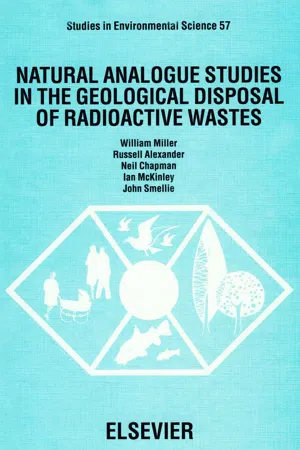
Natural Analogue Studies in the Geological Disposal of Radioactive Wastes
- 394 pages
- English
- PDF
- Available on iOS & Android
Natural Analogue Studies in the Geological Disposal of Radioactive Wastes
About this book
The first purpose of this book is to provide a comprehensive review of the state of development of natural analogue studies with emphasis on those studies which are relevant to the following repository designs: Nagra (Switzerland) disposal concepts for high-level waste/low and intermediate-level waste; SKB (Sweden) disposal concepts for spent fuel/low and intermediate-level waste; and Nirex (UK) disposal concept for low and intermediate-level waste.The book's second aim is to discuss the expanding application of natural analogues for non-performance assessment purposes, especially their potential for presenting the concept of geological disposal to various interested audiences in a coherent, understandable and scientifically legitimate manner.Much of the discussion of the book is relevant to concepts for geological disposal of radioactive wastes by other countries, and is concerned only with those physico-chemical processes which control the release of radionuclides from the near-field, and their subsequent retardation and transport in the geosphere.
Frequently asked questions
- Essential is ideal for learners and professionals who enjoy exploring a wide range of subjects. Access the Essential Library with 800,000+ trusted titles and best-sellers across business, personal growth, and the humanities. Includes unlimited reading time and Standard Read Aloud voice.
- Complete: Perfect for advanced learners and researchers needing full, unrestricted access. Unlock 1.4M+ books across hundreds of subjects, including academic and specialized titles. The Complete Plan also includes advanced features like Premium Read Aloud and Research Assistant.
Please note we cannot support devices running on iOS 13 and Android 7 or earlier. Learn more about using the app.
Information
Table of contents
- Front Cover
- Natural Analogue Studies in the Geological Disposal of Radioactive Wastes
- Copyright Page
- Contents
- Chapter 1. Introduction
- Chapter 2. The disposal concepts
- Chapter 3. Selecting analogue studies
- Chapter 4. Analogues of Repository Materials
- Chapter 5. Radionuclide release and transport
- Chapter 6. Applying natural analogue information
- Chapter 7. Status of natural analogue studies
- Chapter 8. Conclusions
- A Descriptions of natural analogue studies
- References
- Index